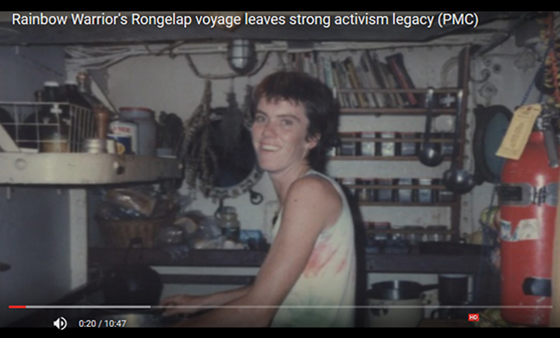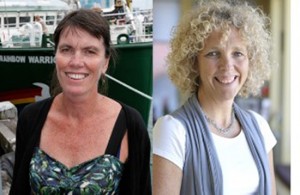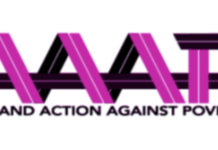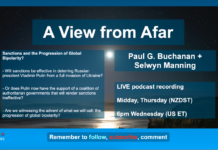
This video interview with Bunny McDiarmid was by the Pacific Media Centre’s Alistar Kata to mark the 30th anniversary of the bombing of the Rainbow Warrior last July.
David Robie also blogs at Café Pacific
Two women – the first to head the global environmental group Greenpeace International – will take up the reins in an innovative co-leadership role in April. Greenpeace International have named New Zealand’s Bunny McDiarmid and Jennifer Morgan for the post, succeeding Kumi Naidoo. Report from Pacific Media Watch
Greenpeace International has named not only its first female international executive director, but two.
Jennifer Morgan and Bunny McDiarmid will take up the reins in an innovative co-leadership role on April 4.

Bunny is a 30-year veteran of the organisation as an activist, ship’s crewmember, and most recently the executive director of Greenpeace New Zealand which, under her leadership, became a powerhouse of innovation in the Greenpeace world.
She has walked the decks of nearly every Greenpeace ship.
Jennifer has walked the corridors of power. As global director of the Climate Programme at the World Resources Institute she has dealt with heads of state and CEOs.
She has been a leader of large teams at major organisations, a climate activist, and a constant innovator. Her other ports of call have included the Worldwide Fund for Nature, Climate Action Network, and E3G.
According to board chair Ana Toni:
“We knew that both of these proven leaders could do the job on their own. But, when we looked at their amazingly complementary skills and experience, the blend of knowledge they would bring, and the challenges we know this job presents to any single individual, we looked back over the literature of co-leadership and were compelled by one of its core advantages: resilience.
“And so, we decided to seize the amazing opportunity of the two of them co-leading the organisation. It’s a move consistent with our general shift away from being a highly centralised, hierarchical organisation, to one that is leaderful: one in which everyone is empowered and where responsibilities are shared.”
Jennifer Morgan was born in the US, lives in Germany, and got her masters degree in International Affairs at American University.
She remembers clearly the day she found a slim book, Fighting for Hope, by Petra Kelly, founder of the German Green Party, in the student lounge.
“I didn’t move for the next several hours. I read the entire thing in one sitting. Kelly linked systemic problems and the need for new ways of thinking, she talked about the role of violence in society and the importance of reconnecting with nature as if someone had written down everything in my heart and mind that I hadn’t been able to express.
“I found her incredibly courageous, and she became a role model for me in a way that changed my life.”
“I know this sounds corny, but coming to Greenpeace feels like coming home. I’ve been out in the world, I’ve walked among government leaders and the halls of the corporate world.
“Greenpeace is much closer to my roots, and has this incredible advantage in its independence: the policy of refusing government or corporate donations means there’s no need pull punches for fear of offending anyone.”
Bunny McDiarmid was born in New Zealand, and says she tried lots of “-isms” while she was at Canterbury University to explain the world she was growing up in. She wasn’t won over by anything – until she found herself, at 21-years-old, on a wooden boat, replacing rotting pieces of timber below the waterline in preparation for going to sea with a community of 12 people.
“I had no carpentry or sailing experience, and this was a job that could mean sink or swim if I got it wrong. But people trusted me, believed I could do it, and I learned then and there that you can be more than what a piece of paper says you can be.” Bunny was a deckhand aboard the Rainbow Warrior in 1985, when Greenpeace moved the people of Rongelap from their island home that had been contaminated by radiation from decades of atmospheric nuclear weapons tests.
“I saw a confluence of connection in the violence we do to Earth and the violence we do to people, and I was witness to how little it mattered to those who were doing it. The story of Rongelap was a tiny metaphor for a far bigger story that drew me in, and bonded me to the ideas that Greenpeace stands for.”
Trust-builders
Ana introduced the two through a series of meetings beginning in October, where Jennifer and Bunny have gotten to know each other and found their visions, their ideas about leadership, and their people-centered styles compatible: their ease with one another is obvious.
“We’re both trust-builders. We both encourage respectful challenge cultures. We both believe you create highly effective teams by harnessing diversity of thought and approach,” said Bunny. Jennifer notes that women are particularly good at sharing power.
“We’re good at bridging diversity. We’re good at focusing on outcomes and a cause. And while there are plenty of men who could share the helm of Greenpeace, there is something that Bunny and I can do through our leadership to empower young women to dream about their futures – that they can do anything and rise to anything, be it the head of Greenpeace or a head of state.”
Jennifer has been described as an “anti-bureaucrat,” building nimble teams within large structures.
“It’s about the right people, matched to the right goal, rather than structures or organograms. And it’s about building a vision together, step by step, rather than having it imposed. Nothing has been more gratifying to me than creating conditions in which people can operate at their best, clearing the obstacles in front of them, aggregating diverse views and skills into something bigger than the individual components, and watching them hit their stride. There’s no greater reward for a leader than watching talented people succeed and shine.”
Bunny and Jennifer share a vision of finding a “new edge” for Greenpeace.
“People are hungry for a new story that they can believe in, one with a better take on the nature of humanity, the fate of our future, and our connection to the earth and the air and the oceans.
Civil disobedience
“Greenpeace is so well positioned to deliver that – you’re genuinely working across global divisions of North and South, your commitment to civil disobedience and nonviolent direct action gives you unique credibility in speaking truth to power that few institutions enjoy.”
“What we need,” says Bunny, “is to make the creative space and find the confidence to figure out how we combine and aggregate the power of everyone who believes in ‘Greenpeace the idea’ – not ‘Greenpeace the organisation’. Not the bricks and mortar, but the idea.
“How do we combine our rebellious creativity with the rebellious creativity of the millions of people and organisations around the world who believe a better world is possible. How do we empower and accelerate that with humility and urgency?”
Jennifer concludes: “Neither of us knows what that new edge looks like yet. And it may look different in different places. But if there’s a single mission that will mark our leadership, it’s finding that, it’s trying new things and working together through the entire organisation to find it.”
“This whole approach is new and I’d be worried if we weren’t both excited and a little scared by this,” says Bunny. “But in a sense, shared leadership isn’t just about me and Jennifer splitting the job of international executive director between us: it’s about sharing leadership among Greenpeace’s worldwide offices, it’s about sharing leadership with our supporters.
This arrangement is an evolutionary reflection of Greenpeace International’s entire approach: it’s all about sharing – globally – the power, the responsibility, and the challenge to rise, to become the best we all can be in a time of environmental threat and existential opportunity.”
“If we bring out the best in each other, we get a better organisation. If we can bring out the best in humanity, we get a better world.”
Source: PMW 9541





They had better get moving fast because planetary meltdown is accelerating.
‘Annual mean carbon dioxide level measured at Mauna Loa, Hawaii, grew by 3.17 ppm (parts per million) in 2015, a higher growth rate than in any year since the record started in 1959.’ (now 4 to 5 times the original 0.7ppm per annum)
http://robinwestenra.blogspot.co.nz/2016/01/climate-change-report-01152015.html
and it will be their generation that will be faced with the dire consequences of decades of failure to ‘stop the machine’.
Comments are closed.